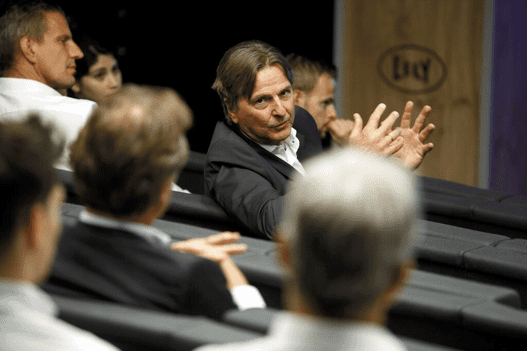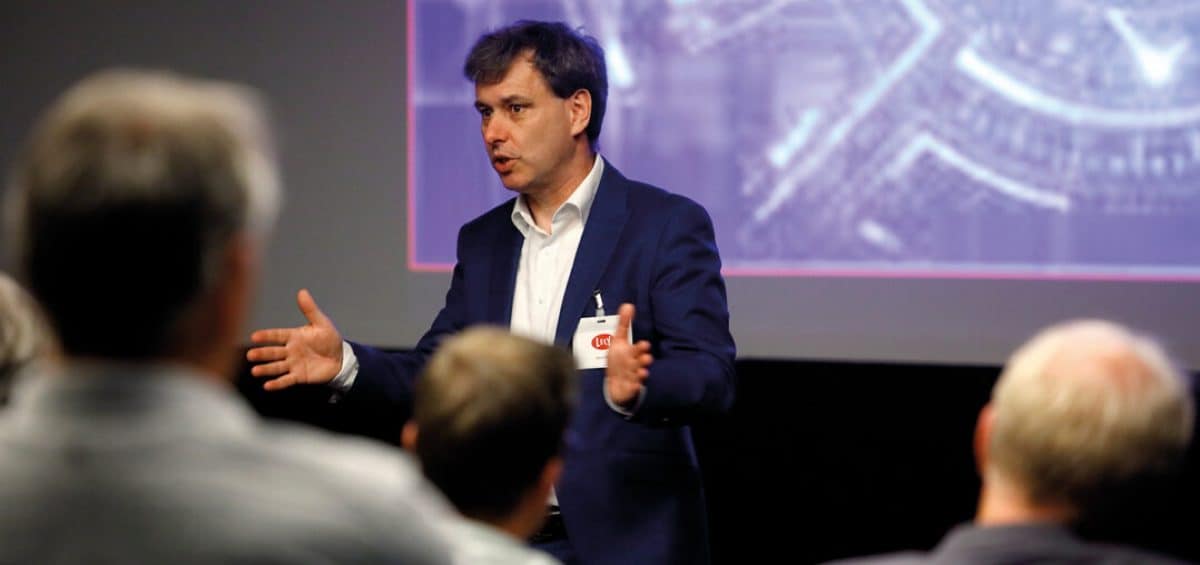This is an excerpt from a Link Magazine article that can be read in full here: Importance of the servitization platform
More efficient troubleshooting
Whereas Moers takes an in-depth look at predictive maintenance, the second speaker focuses directly on data that may be of value for corrective maintenance. Or taking things further: troubleshooting. Esben Rasmussen from Dezide sets out the benefits of using an expert system to resolve faults as quickly, efficiently, and cheaply as possible. He demonstrates a self-learning software platform developed in-house at the company that enables faults to be traced up to 70 percent faster. The more (correct) available data, the more accurately the system can identify a cause.
‘80 percent of troubleshooters call a colleague as the first course of action.’
Rasmussen is a co-founder of Dezide. For over twenty years, it has been developing solutions that enable companies to improve their efficiency based on available data and accumulated knowledge. Dezide is an expert in troubleshooting that considers the associated causes, opportunities, actions, questions, costs, and time. Rasmussen: ‘We now offer a technically oriented platform that makes troubleshooting much more efficient. Instead of having to visit a particular site five times, the actual cause can be identified with just one visit, and the problem is solved. This can even be done remotely in some cases, so the technician immediately knows which materials and tools to take along. The platform is also beneficial for new employees who do not yet have the knowledge and experience to resolve faults efficiently. Last but not least: by finding the cause quickly – ideally according to the first time right principle – you also avoid the costs associated with replacing parts that are not the source of the problem. This also improves sustainability.’

Esben Rasmussen (Dezide): ‘As an 18th-century priest once remarked: the symptom says something about the cause. The cause leads to the symptom.’
What to do with data?
As Dezide is well aware, many companies collect a large amount of data but do not fully use this information. Reports disappear into a drawer. ‘That’s unfortunate and not necessary,’ says Rasmussen. ‘The various measurement data provided by assets, including pressure, temperature, on/off states, failures, and so on, constitute valuable knowledge for technicians, who can use this data to solve problems. Or, as an 18th-century priest once remarked: the symptom says something about the cause. The cause leads to the symptom.’
Processing power
The collection of data and its subsequent processing in models that provide information is of specific value to troubleshooting. ‘Troubleshooting tasks take up an enormous amount of time. Many companies employ hundreds or even thousands of technicians to solve issues with machines alone. Making specialist knowledge available can save a large amount of time and money. In addition, data facilitates a structured approach to problems that build up and maintain knowledge. This knowledge is then entered in computer models that are continually improved and can be used to support new technicians or those with less training or experience.’ Colleagues around the world can make use of each others’ expertise, wherever they may be.
Data-based troubleshooting benefits from the increasing processing power of computers, as Rasmussen explains: ‘At the outset, it’s unclear which data relates to the actual problem. However, computers can process data at lightning speed in a suitable algorithm. As more data becomes available from the field, the models become increasingly adept at identifying a problem in one step. And therefore also the solution.’

Discussion about the service models, with Eric Lapré from VMI speaking.
Rasmussen: ‘Studies have shown that 80 percent of troubleshooters call a colleague as the first cause of action when faced with a problem. They want to see if the colleague knows or recognizes the symptoms and has any ideas about a possible cause. As a result, many people are always unavailable for other tasks. People learn more slowly than computers. There is also a significant risk that previously devised solutions will simply be forgotten. Knowledge is mainly lost when people leave a company, which can also be prevented by storing this know-how in a structured way in smart software.
Troubleshooting has not always become easier in recent times. In addition to being mechanical, the related faults could just as easily involve software, IT, or electronic components. ‘Systems and machines have become more complex over the years, influencing troubleshooting.’
Development platform
The software solution developed by Dezide is based on ‘decision-theoretic troubleshooting.’ Rasmussen: ‘When we build a computer system based on decision theory, it often takes the form of an expert system that provides advice to people in certain contexts or that semi-automates certain tasks. This creates a system that synthesizes expert human knowledge with the large processing power of a computer. This fusion is made possible by an underlying mathematical model. The better the algorithm, the earlier you will arrive at the actual cause of a problem. This not only speeds up troubleshooting but also makes it more user-friendly.’ Rasmussen cites the example of a customer with earth-moving machines that previously spent around 30 percent of the time looking for the required information in paper or digital documents. ‘In contrast, an expert system automatically guides you through a decision process most efficiently. All roads may lead to Rome, but taking the fastest will save you the most time.’
Route
Rasmussen gives the example of a fault in a car, where answering each question brings the user closer to the solution. The answers provided determine what question is asked next, and a failure to answer a question does not cause the process to stall. The user can simply skip the question, which triggers the system to select a different route for arriving at the correct solution. In addition to the measured values from the system, the troubleshooting algorithm also considers other available data. This may include weather conditions (humidity, temperature) or the GPS location (atmospheric pressure).
Depending on the problem and the level of detail at which information is available, the platform ultimately arrives at one or more solutions. The final phase then involves trying out the different options to see which provides the required results or the troubleshooter deciding on the right solution themselves. Rasmussen: ‘In all cases, the system will store the solution that was ultimately correct and grow smarter over time.’
The tool also links decisions to costs, making it easier to choose the more cost-efficient proposal in some cases. And the total costs for a solution can subsequently be recorded more accurately. ‘Several large companies have already benefitted from the associated advantages,’ concludes Rasmussen. ‘Although a solution of this type is less suitable for an SME, it is worth investigating what it can offer to companies with over a hundred employees.’


